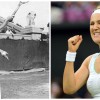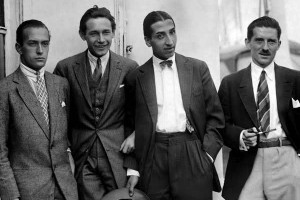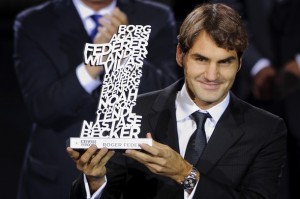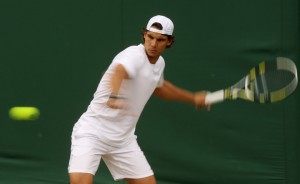by Randy Walker
@TennisPublisher
Victoria Azarenka’s nasty-looking knee injury suffered early in the second set of her 6-1, 6-2 win over Maria Joao Koehler in Monday’s Wimbledon first round had the feel to a similar circumstance that happened in the 1931 Wimbledon semifinals featuring the grandfather of actress and model Brooke Shields.
Azarenka, seeded No. 2, was leading 6-1, 1-0 when she slipped on the lush grass on Court No. 1 at the All England Club and awkwardly stretched her right knee. As she sobbed on court in pain, she was treated, helped to her courtside chair, had her knee taped and resumed play after about twenty minutes. Azarenka hobbled gingerly after the injury and blasted her way with quick points, mixed in with winces of pain, to close out the victory.
The circumstance was reminiscent of a famous incident involving Frank Shields during his Wimbledon semifinal match against French Musketeer Jean Borotra.
The dramatic events – that some have described as a real-life tennis version of the conclusion to the Robert Redford movie “The Natural” – is described in the book THE WIMBLEDON FINAL THAT NEVER WAS…AND OTHER TENNIS TALES FROM A BYGONE ERA by Sidney Wood ($15.95, New Chapter Press, available here: http://www.amazon.com/dp/0942257847/ref=as_li_tf_til?tag=tennisgrancom-20&camp=14573&creative=327641&linkCode=as1&creativeASIN=0942257847&adid=1AQ5QP7HDX2NG1FHNB7F&&ref-refURL=http%3A%2F%2Fwww.tennisgrandstand.com%2F
This excerpt, compiled by Wood’s son David in the book, is excerpted below.
Shields led Borotra two sets to one and serving at 4-3, 40-30 when the infamous injury happened. He slipped on a ball at the net and fell hard to the ground in clear pain, twisting his knee. Borotra ran to the net to help Shields. He held his arm, guided him to the sidelines and brought him water and his coat for comfort. He even began to rub the injured knee of his fallen opponent. Shields eventually wobbled back to the baseline and attempted to continue play. So uncertain of the match continuing as Shields limped, the chair umpire needed assurance and asked, “Are you alright, Shields?”
Wrote Ferdinand Kuhn in The New York Times, “The crowd thought it was about to witness a debacle almost at the moment of Shields’s victory. Once more, both players left the court, but this time Shields, though still limping, would not hear of a postponement. The Frenchman, still skeptical, ran back to his position, waiting for Shields to finish his service. Shields answer was swift and ruthless when it came.”
Shields limped to the line and delivered one mighty unreturnable cannonball serve. Borotra was not able to return the bolt of lightning, and with one swing of the racquet, Shields held serve for a 5-3 lead. Faced with the prospect of only having to hold serve on his next service game to reach the Wimbledon final, Shields did not put forth any effort as Borotra served the next game, saving his fitness and the risk of further injuring his tender knee. After Borotra held serve easily for 4-5, Shields then served for the final.
Shields fired an ace on his first swing of the racquet. 15-0. Another cannon shot was fired that Borotra got his racquet on, but the Frenchman hit the ball beyond the baseline. 30-0. Shields missed a volley on a sojourn to net on the next point to draw Borotra to 30-15, further confirming that Shields would likely have to win the point outright on the serve if he were to close out the match. After missing a first serve on the next point, Shields was given a gift as Borotra netted the second-serve return, giving Shields double match point at 40-15. All he would need is one more swing of the racquet, blazing another ace past Borotra to close out the dramatic victory.
Wrote Kuhn in The New York Times, “Finally, at match point, a sizzling serve flew past Borotra with the speed of a high velocity shell. The match was over and Shields walked off the court amid one of the greatest and friendliest ovations any American winner has had at Wimbledon.”
Shields famously did not play in the Wimbledon singles final against his U.S. Davis Cup teammate, roommate, doubles partner and good friend Sidney Wood – in even more unusual circumstances as outlined in the book. Azarenka’s status for the rest of the tournament is somewhat questionable. She told ESPN on Monday that she has seen a doctor who said that the injury “doesn’t seem that bad” but that time will tell if she will be able to play her second-round match on Wednesday or if the knee will hold up for the two weeks of the tournament.




